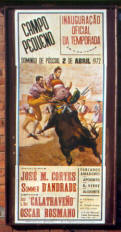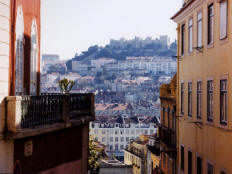Page 1 2 3 4 5 6 7 8 9 10 11 12 13 14
Sunday, 2 April (continued). After a stop for lunch (good food, bad service), the bus took us to the
Placa do Touros (bull ring) for a bullfight at 1515.
The event started with great pageantry. All the various participants (except
the bull) lined up in formation in the ring.
We knew they didn't kill the bull in a Portuguese bullfight, but we discovered
there are many other significant differences from the Spanish version. First, two horsemen (cavaleiros) harried and
weakened the bull by sticking banderilleros in its hump.
Next, several men on foot (forcados) lined up in a row in front of the bull and absorbed his charge until their combined weight actually stopped the bull. As the bull weakened (mostly from the banderillos), the forcados twisted its horns and once even forced it to fall to the ground. In the next stage of the bullfight, two men on foot (toureiros or matadores) took turns fighting the weakened bull with cape and sword, but only made a symbolic “kill.”
As if that wasn't enough, another cavaliero harassed the poor bull that by now could barely move. The bull was not killed in the ring, but we were told that he would be slaughtered afterwards. Although it was an interesting spectacle, it certainly wasn't sporting.
Built on one of Lisbon's seven hills, Alfama is very hilly. There are steps everywhere, some wide, some narrow, but all very picturesque. This is the oldest part of the city and, as is usually the case, home to some of the poorest inhabitants. Most of the buildings date back to the four centuries of Moorish occupation (8th-12th century).
We roamed the area for nearly two hours, until the sun
was long gone. They finally got back to the hotel about 20:00, just in time for
dinner. That evening, Jane joined others from our group at a night club featuring Fado, Portugal’s
beautiful and touching, yet very sad, classic-folk singing. Page 1 2 3 4 5 6 7 8 9 10 11 12 13 14
Copyright © 2000-2023 DarrellPeck.com All rights
reserved. | ||||||||















